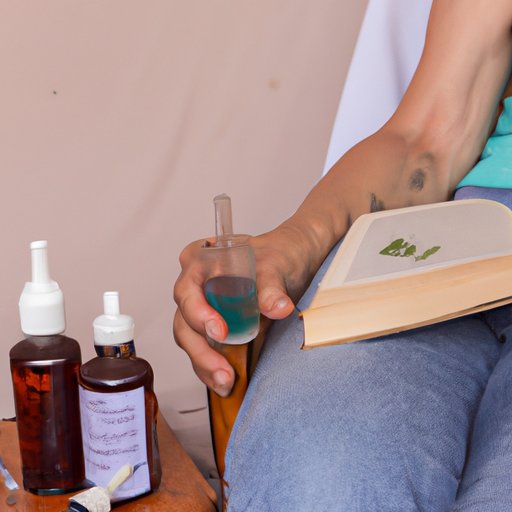
I. Introduction
Edema is a medical condition that occurs when there is an excessive buildup of fluid in the tissues of the body. It can occur in different parts of the body, such as the legs, feet, ankles, and hands. When left unaddressed, edema can cause discomfort, pain, and mobility issues. That’s why it’s important to learn more about edema and how to treat it. The good news is that there are different treatment options available to address edema. These include home remedies, natural remedies, lifestyle changes, and medical treatments.
II. Breakdown of Edema
Edema is caused by the accumulation of fluid in the tissues of the body. Various factors can cause this accumulation, including certain medications, pregnancy, heart and kidney diseases, and long periods of inactivity. Common symptoms of edema include swelling, discomfort, and limited mobility. Depending on the severity of the condition, there are different treatment options available to manage edema.
III. Home Remedies
Home remedies are non-medical treatments that can be used to manage various health conditions, including edema. Home remedies can be effective in reducing edema symptoms and promoting overall wellness. Some of the most effective and readily available home remedies for edema include:
- Low-sodium diet: Consuming less salt can help reduce swelling in the body. It’s recommended to avoid processed foods and choose fresh fruits and vegetables instead.
- Leg elevation: Elevating your legs can help reduce swelling in the legs and feet. Lie down and elevate your legs above your heart for 15-20 minutes several times a day.
- Exercise: Exercising and stretching can improve blood flow and reduce swelling in the body. Walking, swimming, and cycling are great low-impact exercises to try.
- Compression garments: Wearing compression stockings or sleeves can help improve blood flow and reduce swelling in the legs.
- Massage: Gentle massage can help promote lymphatic drainage and reduce edema symptoms. Massage the affected areas using gentle strokes and circular motions.
IV. Natural Remedies
Natural remedies are another non-medical treatment option for edema. Some natural remedies can help reduce inflammation and promote healthy blood flow in the body. Some of the most effective natural remedies for edema include:
- Essential oils: Certain essential oils like cypress, lavender, and lemon can help reduce swelling and inflammation in the body. Add a few drops of essential oil to a carrier oil and gently massage into the affected areas.
- Herbs: Certain herbs like ginger, dandelion, and parsley can act as natural diuretics and help reduce swelling in the body. Brew these herbs into tea or add to meals for added benefits.
- Apple cider vinegar: Drinking diluted apple cider vinegar can help reduce swelling in the body. Mix one to two tablespoons of apple cider vinegar with water or juice and drink daily.
- Tea tree oil: Tea tree oil can help reduce inflammation and promote lymphatic drainage. Add a few drops of tea tree oil to a carrier oil and gently massage into the affected areas.
V. Lifestyle Changes
Lifestyle changes can also be effective in managing edema. Certain lifestyle habits can contribute to edema symptoms and should be avoided or modified. Some of the most effective lifestyle changes for managing edema include:
- Exercising regularly: Regular physical activity can improve blood flow, reduce inflammation, and promote overall health. Aim for at least 30 minutes of moderate exercise daily.
- Avoiding long periods of sitting or standing: Prolonged inactivity can contribute to edema symptoms. Try to move around and stretch regularly if you have a sedentary job or lifestyle.
- Quitting smoking: Smoking can contribute to inflammation in the body and reduce blood flow. Quitting smoking can improve overall health and reduce edema symptoms.
- Eating a healthy diet: Consuming a diet rich in fruits, vegetables, whole grains, and lean protein can promote overall health and reduce inflammation in the body.
VI. Medical Treatments
If edema symptoms are severe or persistent, medical treatments may be necessary to manage the condition. Different medical treatments are available depending on the severity and underlying cause of edema. Some of the most common medical treatments for edema include:
- Diuretics: Diuretics are medications that help the body eliminate excess fluid and reduce swelling. They can be taken orally or administered through an IV.
- Compression stockings: Wearing compression stockings can help improve blood flow and reduce swelling in the legs and feet.
- Surgery: In severe cases of edema, surgery may be necessary to remove excess fluid and tissue from the affected area. This is typically a last resort for managing edema.
VII. Conclusion
Edema can be a discomforting and painful condition to deal with, but there are different treatment options available to manage it. Depending on the severity and underlying cause of edema, home remedies, natural remedies, lifestyle changes, and medical treatments are available. It’s important to seek professional medical advice and guidance to determine the best treatment options that suit your needs and symptoms. In the meantime, however, you can start with the tips and recommendations mentioned above to manage your edema symptoms and promote overall wellness.




